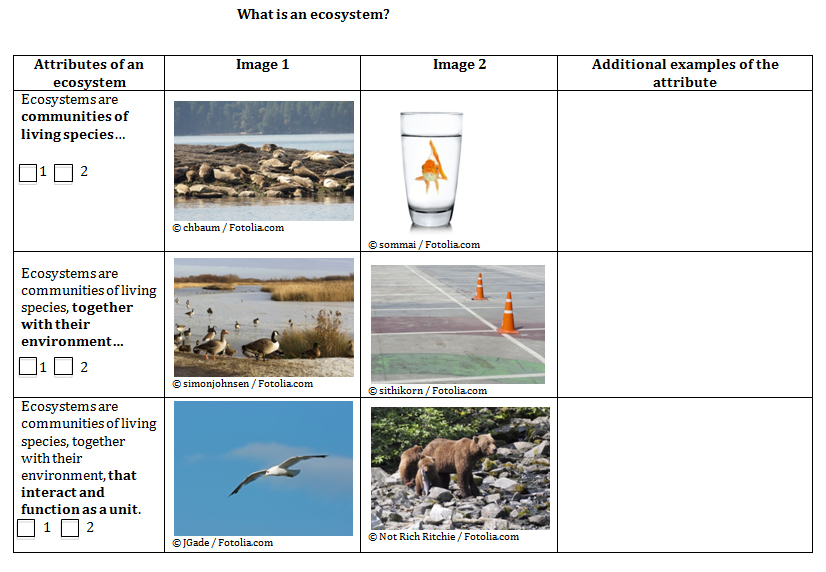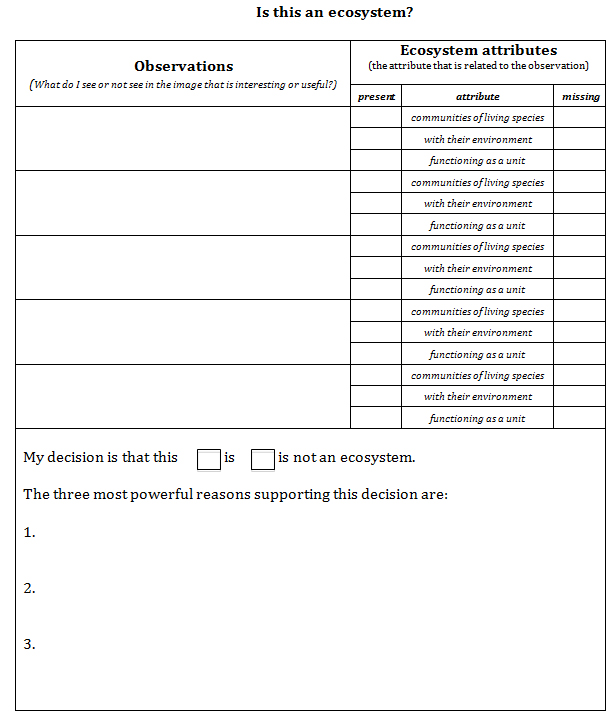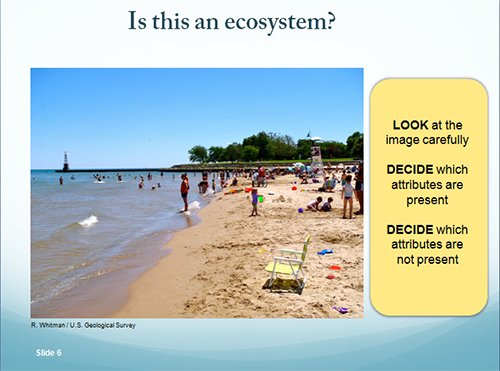Publications
Human Activity and the Environment – Teacher’s Kit
- 16-507-X
- Main Page
-
Lesson #1:
What is an ecosystem? -
Lesson #2:
What are ecosystem goods and services? -
Lesson #3:
How can the value of ecosystem goods and services be measured? -
Detailed lesson plan #1:
Can the value of ecosystems and ecosystem goods and services be measured? -
Detailed lesson plan #2:
The value of ecosystem goods and services in changing ecosystems -
Case study #1:
Thousand Islands National Park case study -
Case study #2:
Exploring methodologies for measuring ecosystem goods and services - Image collection
- More information
- PDF version
Lesson #1 What is an ecosystem?
Overview
This PowerPoint lesson describes use of the nine slides in Set #1 and related learning activities to explore the attributes of ecosystems. Using a series of images, learners recognize three key ecosystem attributes. They use these traits to determine whether or not an area portrayed in an image could represent an ecosystem. Learners discover the differences between ecosystems and habitats. Finally, learners examine a provocative image to determine whether it is an ecosystem or habitat.
Audience
- junior high school
- senior high school
- introductory post-secondary
Learning outcomes
- understand the attributes of ecosystems
- understand the importance of studying ecosystems
Curriculum links
- grades 7 to 12 geography (ecosystems, geographic change), social studies (economics), biology (ecosystems and change), science, economics (accounting, valuation methods)
- post-secondary geography (ecosystems), environmental science (ecosystem accounting, ecosystem change)
Learning materials
- PowerPoint slide set #1: What is an ecosystem? (PPT) (PDF) (HTML)
- Statistics Canada publication, Human Activity and the Environment 2013: Measuring ecosystem goods and services in Canada
- Activity sheet #1: Explore the attributes (DOC) (HTML)
- Activity sheet #2: What is an ecosystem? (DOC) (HTML)
- Activity sheet #3: Is this an ecosystem? (DOC) (HTML)
Instructions
Think about the task
Display or project Slide 1 or provide a provocative image to prompt learner reflection on the question “Is this an ecosystem?”
Guide learners in a discussion of what an ecosystem might be and why it might be important to understand and study ecosystems.
Explore the attributes
Organize learners into small groups and provide each group with a copy of Activity sheet #1: Explore the attributes. Display or project Slide 2 and inform learners that it is an image of an ecosystem. Inform learners that their challenge is to identify the attributes that make it an ecosystem.
Remind learners of strategies for making thoughtful observations and encourage learners to record what they observe in the image. Guide learners in using these observations to infer possible attributes of ecosystems.
Invite learners to discuss possibilities with their partner(s) and then share ideas with the class. Record or project learners’ suggestions for the attributes.
Identify the attributes
Provide each learner with a copy of Activity sheet #2: What is an ecosystem? Inform learners that they will be identifying specific attributes of ecosystems.
Display or project Slide 3 and inform learners that one of the attributes of an ecosystem is that it is a community of living species.
It may be helpful to distinguish between ecological and biological. Remind learners that biological refers to specific organisms and how they function, while ecological refers to the interactions and interrelationships of organisms and their environments.
Guide learners in making observations about each image, then ask learners to select the image that best reflects the attribute. Prompt learners to note their decision on Activity sheet #2: What is an ecosystem? Repeat with the additional attributes of an ecosystem (Slides 4 and 5). Inform learners that some aspects of the attribute may not be immediately apparent in the image. For example, communities of living species include plants, animals and microorganisms. Physical environments include many different abiotic components including air, water, soils, minerals, etc.
Review learner decisions for each image, drawing attention to aspects of the images that clarify each attribute.
After identifying each attribute, guide learners in considering other examples of the attribute. Encourage students to consider different types of ecosystems (e.g., forest, cropland, wetland) and determine what examples of each of the attributes might be found in each. Learners may record additional examples on Activity sheet #2: What is an ecosystem?
Apply the attributes
Display or project Slide 6 and inform learners that their next task is to consider all of the attributes to determine if an area is an ecosystem.
Guide learners in making observations and identifying the appropriate attributes. Learners may use Activity sheet #3: Is this an ecosystem? to guide and record their decisions.
Explore the differences
Display or project Slide 7. Encourage learners to identify what they observe in each of the images. Prompt learners to identify which of the attributes of an ecosystem is present or absent in each of the images. Learners may use Activity sheet #3: Is this an ecosystem? to guide and record their decisions.
Ask learners to identify which characteristics distinguish ecosystems from habitat. Prompt learners to share ideas on the most significant differences between an ecosystem and a habitat. Encourage learners to record their ideas. Invite learners to discuss possibilities with a partner and then share ideas with the class.
Inform learners that ecosystems include all the interactions between all the living species and the non-living and environmental factors, while a habitat is an area occupied by a certain species.
Re-examine the image
Display or project the provocative image that was used to introduce the activity (Slide 8). Ask learners to reflect on their initial thoughts: given what they now know about the attributes of ecosystems, is this an ecosystem?
Encourage learners to carefully observe the image and to decide if this is an ecosystem, keeping in mind each of the three attributes. Learners may use Activity sheet #3: Is this an Ecosystem? to guide and record their decisions. Invite learners to share their ideas with the class.
Conclude by posing the question: “Why might it be important to understand and study ecosystems?”
Activity sheet #1

Description for activity sheet #1 (DOC)
Activity sheet #2

Description for activity sheet #2 (DOC)
Activity sheet #3

- Date modified:





